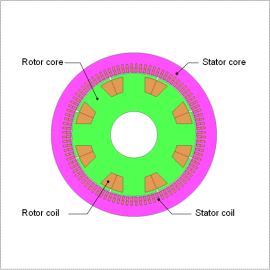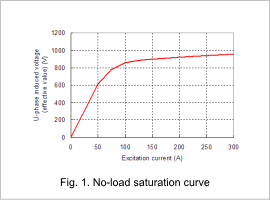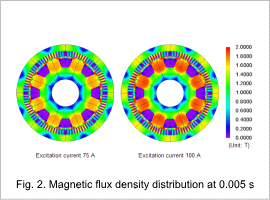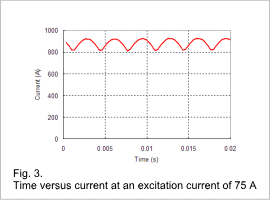*Please prepare a license ID and password for the license administrator.
*It is different from the service for JMAG WEB MEMBER (free membership). Please be careful.
Overview

Salient-pole synchronous generators are used in hydroelectric generators and the like. Power is generated in the stator coils (armature) by a field current flowing in the rotor coils and the rotor rotating.
Reactions occur between the field current and the armature current that either strengthen or weaken the magnetic flux depending on the power factor of the connected load of a salient-pole synchronous generator. This causes the operating point of the magnetic circuit inside the generator to change, which affects the output. The core normally has nonlinear magnetic properties, so an evaluation of the magnetic circuit with magnetic field analysis, which can handle nonlinear magnetic properties, is useful.
This Application Note presents the use of a magnetic field analysis to obtain the magnetic flux density distribution, no-load saturation curve, and output of a salient-pole synchronous generator.
Reactions occur between the field current and the armature current that either strengthen or weaken the magnetic flux depending on the power factor of the connected load of a salient-pole synchronous generator. This causes the operating point of the magnetic circuit inside the generator to change, which affects the output. The core normally has nonlinear magnetic properties, so an evaluation of the magnetic circuit with magnetic field analysis, which can handle nonlinear magnetic properties, is useful.
This Application Note presents the use of a magnetic field analysis to obtain the magnetic flux density distribution, no-load saturation curve, and output of a salient-pole synchronous generator.
No-load Saturation Curve / Magnetic Flux Density Distribution
The no-load saturation curve is shown in fig. 1, and the magnetic flux density distributions for excitation currents of 75 A and 100 A at 0.005 s are shown in fig. 2. The slope of the no-load saturation curve begins to decrease after exceeding an excitation current of 75 A. The magnetic flux density increases in the teeth of the rotor core and stator core as the excitation current gets larger, and the slope of the no-load saturation curve decreases as magnetic saturation increases. The effective value of the induced voltage is obtained using the root mean square.


Output

The time versus current of the shaft resistance at an excitation current of 75 A is indicated in fig. 3. The output current of this salient-pole synchronous generator is 880 A.


